#al jorgensen
Explore tagged Tumblr posts
Text
youtube
Ministry - In Case You Didn’t Feel Like Showing Up (full show)
#ministry#in case you didn’t feel like showing up#bill rieflin#Al Jorgensen#paul barker#chris connelly#Youtube
1 note
·
View note
Text
Elvis' perfectionism 📀
Author's note: Okay, I'm beyond excited with this post, so please take your time reading it. You won't regret a bit.

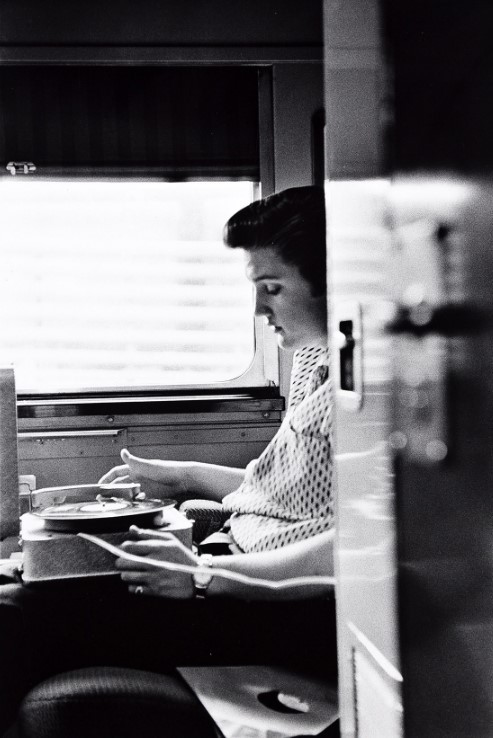
So, things just got more interesting for me.
If you read my content for a while now, you must be familiar with the fact that I'm a huge fan of "Elvis On Tour" documentary. There's this scene in the middle of the movie where they play instrumental of "Don't Be Cruel" while some 50s pictures of Elvis are "randomly" shown onscreen... well, not as random as one may think.
"Elvis On Tour" is mainly a live concert documentary but it tells Elvis' history as well. His history as a musician is delivered through his own accounts (Elvis talking about his music preferences, his love for gospel music, etc) and by family members' accounts too, such as an interview with Vernon Presley, his father, that is also featured on the film, when Mr. Presley talks about how Elvis' tours in the 50s were wild with all the fans going extremely hysterical over his son.
One of the pictures in particular, displayed during the "throwback scene" in the movie, is immensely significant to the story that documentary meant to tell the viewers. This one right here:


July 3, 1956: On The Train back to Memphis, Tennessee. Photograph by Alfred Wertheimer. Below, other pictures from the same moment. Note the little record player on Elvis' lap, it is important.

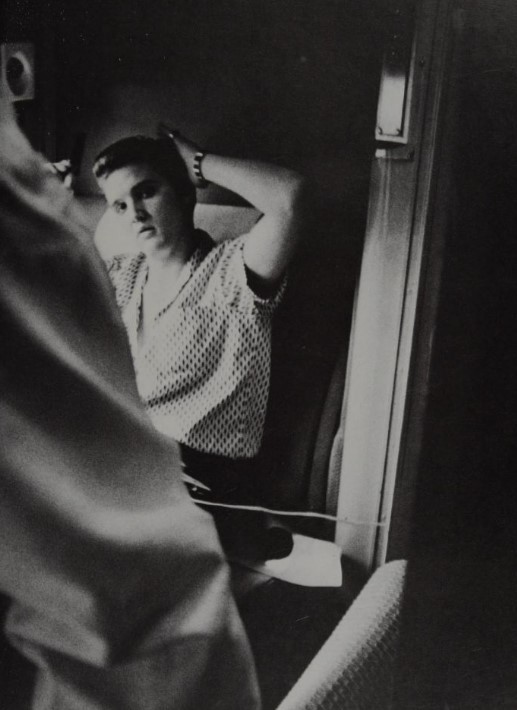

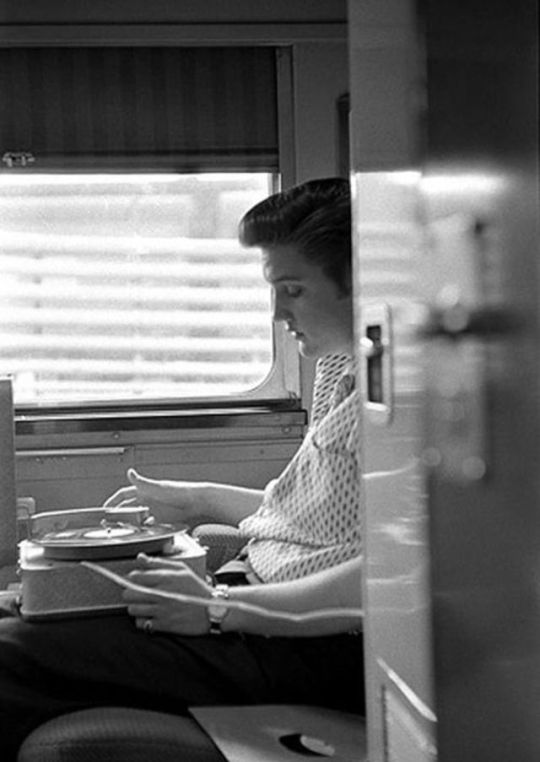
The day before those pictures on the train were taken, Elvis had cut some new songs, soon to be released, "Hound Dog" and "Don't Be Cruel" are among them, but also "Any Way You Want Me".
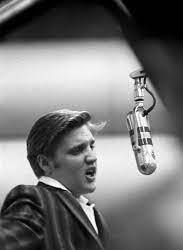




Elvis during Studio Sessions for RCA July 2, 1956, at RCA Studios in New York. Photograph by Alfred Wertheimer.
About that recording session, on the precise moment EP was recording "Hound Dog", below is an excerpt from "Elvis Presley: A Life in Music" by Ernst Jorgensen and Peter Guralnick:
This was the session where Elvis’s perfectionist streak first became apparent. From [Steve] Sholes’s point of view several of the earlier takes would have been just fine, and he tried to get the singer to listen to the playbacks, but it was obvious that the singer was marching to his own beat; he wouldn’t rest until he had recorded the song to his own — not anyone else’s — satisfaction. Finally, with thirty-one, Elvis declared himself satisfied, and the room breathed a sigh of relief.
Side note: Before recording the song on studio, Elvis performed "Hound Dog" on the Steve Allen Show, on July 1, 1956. They were all worried about how to turn the live performance into a record, and Elvis was the one who was intensely dedicated to make it work. That's why he took 31 takes to finish working on particular track. It really paid off in the end.
Back to the train pictures on July 3, 1956, the photographer, Alfred Wertheimer, shared his accounts on the moment. He said:
"Elvis in on the train. He had just recorded these three songs but two of them became his third and fourth gold records: "(You Ain't Nothing But A) Hound Dog" was the third and "Don't Be Cruel" was the forth. Here he's listening to it over and over again on the way down to his home [Memphis, Tennessee], and he's listening it on this inexpensive little record player and here, I mean, while the other musicians are horsing around, while Colonel Parker is somewhere else, Elvis keeps listening and listening and listening. He's a serious guy! I asked him 'Why are you listening to it on this tiny little machine with a terrible speaker and you just heard it yesterday on a fourteen inch speaker in a studio, beautiful reproduction?' He says: 'Al...'
"'...This is the way my fans listen to my music. That's the way I wanna hear it.'"
— Elvis Presley, July 1956
On more train picture (Elvis going to Memphis, Tennessee on July 3, 1956):

On that photograph, Alfred Wertheimer said on 'Elvis '56' book:
"Listening to the previous day's work one more time before going to sleep, his teddy bear keeping him company. The record player is sitting on a ledge to the right of his berth."
youtube
ABOVE: "Elvis On Tour" (1972) snippet with "Throwback scene". Instrumental of "Don't Be Cruel" is playing on the background while pictures from Elvis' early tours are displayed onscreen. The first picture, that one from July 3, 1956, that Mr. Wertheimer shared his memories about.
The footage on that scene from the documentary is from September 9, 1956 on The Ed Sullivan Show. If you'd like to watch the full performance, here it is:
youtube
Well, I don't know about you but I will never see the throwback scene the same way.
I mean, if I'm being honest here, I used to often skip that scene just because I've seen the pictures over and over again and the footage from Ed Sullivan Show as well, so when I watch the film I used to be much more interested on the 1972 live performances, the backstage scenes and so on, but now I know the story of that picture, the scene is a lot more meaningful. That 1972 documentary, friends, is not only about Elvis' performances or the lasting love and adoration from his fans. It has a lot more to do with who Elvis Presley was, specially how he felt about music and how he gave all of him to please us. The film shows Elvis talking about how, in the 70s, after many, many years of experience onstage he still felt anxious before performing... and that picture from the 50s that is shown on the film tell us his dedication to his music was to the extent of listening his records on home record players just to make sure it would sound as flawless as it could be... all for us. After hearing the picture story from Mr. Wertheimer, I just fell in love with that 1972 documentary, and with El, even more. ♥
#elvis presley#elvis on tour#alfred wertheimer#1956#1972#elvis#elvis the king#elvis fans#elvis fandom#elvis history#50s elvis#70s elvis#elvis music#Youtube
110 notes
·
View notes
Text
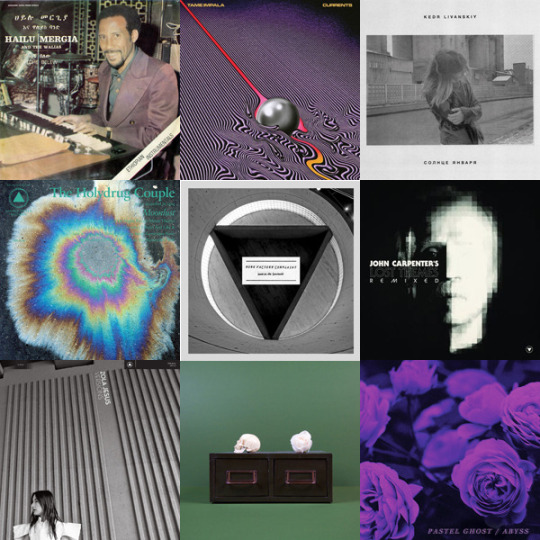
Finds For 2016.
Diet Cig “Scene Sick”
Tame Impala “New Person Same Old Mistakes”
Cold Cave ft. Black Rain & Genesis P. Orridge “Comprehension”
Computer Magic “Be Fair”
George Clanton “Notice Me”
Prurient “Dragonflies To Sew You Up”
Tropic Of Cancer “Stay Safe”
Mssingno Scope
Blanck Mass “Atrophies”
Holydrug Couple, The “Follow Your Way”
Russell Haswell “Spring Break Extended“
In Aeternam Vale “Dust Under Brightness”
Sophie Product
Consumer Electronics Dollhouse Songs
Blanck Mass “Dead Format”
Hibou “Above Us”
UXO self-titled
Follakzoid “Directo Al Sol
Moon Duo “Free Action”
Tearist Living: 2009-Present
Deerhunter “Ad Astra”
Beliefs “1992”
Ducktails “Don’t Wanna Let You Know”
Tame Impala “Nangs”
Candy Snatchers, The “If You Can’t Have Fun, You Ain’t Fun” (live)
Shana Falana “There’s A Way”
DOM “Burning Bridges”
Girlpool “Before The World Was Big”
Holydrug Couple, The “Paisley”
Ash Koosha “Harbour”
Dystopian Future Movies “Paint It Red”
Angry Angles “Things Are Moving (All The Time)”
Polysick “Smudge Hawaii”
Kleenex “Nice”
18+ Fore
Innsyter “Cut Eleven”
Airliner “Her Crutch”
Clams Casino “Drawn” (Crim3s RMX)
Com Truise “Silicon Tare”
Crim3s “Stay Ugly”
Johnny Thunders & The Heartbreakers “Born To Love”
Imaginary Pants Kites At Night
Ana Lola Roman “Klutch” (Com Truise RMX)
Costavision Lo-Fi Exotica
Coachwhips “UFO, Please Take Her Home”
Rubs, The “Runaway”
Airliner “Left Orange”
Sheer Mag “Fan The Flames”
JK Flesh Rise Above
Gigi Masin“Tears Of A Clown”
Reatards, The “You Ain’t Fun No Mo’”
Hussy, The “You Know”
Home “Resonance”
TR/ST “This Ready Flesh”
Pastel Ghost “Clouds”
LNDN DRGS “Dope Sick”
Ata Kak Obaa Sima
Hailu Mergia & The Walias “Yemiasleks Fikir”
Christoph De Babalon “Surreal Mirrors”
Gigi Masin “Fata Morgana"
John Carpenter Lost Themes Remixed
Veldt, The “Sanctified”
Zola Jesus “Collapse”
Merzbow & Keiji Haino & Balazs Pandi “How Differ The Instructions Of The Left From The Instructions On The Right”
Cults “Oh My God”
Vektroid “Neo Cali”
FOE “Genie In A Coke Can” (Alec Empire RMX)
Peaches “How You Like My Cut?” (Ziur RMX)
Tex Taiwan “Algorhythm Vision”
Jagwar Ma “Uncertainty” (Mssingno RMX)
Odesza “It’s Only” RMXs
Honeyblood “Sea Hearts”
Connie Laverne “Can’t Live Without You”
Kedr Livanskiy January Sun
Body-San “Shining The Money Ball”
C.V. Jorgensen “Ghetto Svend”
9th Wonder & Buckshot ft. Talib Kweli “Hold It Down”
Uniform “Symptom Of The Universe”
Czarface ft. Vinnie Paz & Cappadonna “Shoguns”
D.I.T.C. “Rock Shyt”
Lizzy Mercier Descloux “Fire”, “Wawa”
David “Baby” Cortez “Happy Organ”
Low Red Center s/t
Alan Turing “God Save The King / Baa Baa Black Sheep / In The Mood”
Dolly Parton “Jolene” (33 RPM)
Tobacco “Gods In Heat”
Pere Ubu “Blow Daddy-O”
La Coka Nostra “Waging War”
Elusive Textures
Technicolor Skull “Technicolor Skull”
Hanin Elias ft. Electrosexual “Hold Me”
IKO 93 “Drag” / “Mutt”
Innsyter Poison Life
Bloom Offering “Bite Their Tongues”
Jlin “Downtown”
Sandro Brugnolini & Stefano Torossi “Effetto Notte”
Comet Gain “(All The) Avenue Girls”
Nick Klein “Anxiety Plae”
Le Matos “Eyes Throat Genitals”
Bill Loose “Slight Misgivings”
L-Fudge Chronic Irresponsibility
Author & Punisher “Lust For Scales”
Sun Ra “The Cosmic Explorer”
Liquids Hot Liqs
Ice Cream Love, Ice Cream
Khost “Deathset” (Godflesh RMX)
Ramleh “Airborne Babel”
L-Fudge ft. DJ Spinna, Shabaam Shadeeq & Talib Kweli “What If?”
Caroline K “Tracking With Close-Ups”
Rosa Yemen “Herpes Simplex”
Jonas Reinhardt “Androma”
Sunrise Ltd. “Our Love Will Grow”
Tearist “Headless”
Red Fetish “Spanish Meths”
Hot Chocolate “Could Have Been Born In The Ghetto”
Vibrators, The “Disco In Moscow”
York Factory Complaint Lost In The Spectacle
Nick Klein I’d Rather Sit Alone
#omega#music#playlists#mixtapes#personal#electronic#experimental#noise#industrial#punk#synthpop#no wave#hip-hop#rap#garage#alternative#country#pop#goth#vaporwave#indie
9 notes
·
View notes
Text
By: SEGM
Published: Jun 11, 2023
A new peer-reviewed article, “Transition Regret and Detransition: Meaning and Uncertainties,” published in the Archives of Sexual Behavior, reviews clinical and research issues related to transition regret and detransition. The article emphasizes that “although recent data have shed light on a complex range of experiences that lead people to detransition, research remains very much in its infancy,” and there is currently “no guidance on best practices for clinicians involved in their care.”
The author, Dr. Jorgensen, notes that the term “detransition” can hold a wide array of possible meanings for transgender-identifying people, detransitioners, and researchers, leading to inconsistencies in its usage. Although regret and detransition overlap in many people, not everyone who regrets their transition takes steps to detransition and conversely, not all of those who detransition regret their transition. Proponents of the “gender-affirming care” model typically focus on the latter group who are driven to detransition by external forces such as discrimination, lack of support from family and friends, or difficulty accessing health care. Euphemisms such as “gender-identity journey” and “dynamic desires for gender-affirming medical interventions” have been used to describe this process.
But the author highlights studies and personal testimonies of detransitioners who do deeply regret their transition, mourn the physical changes made to their bodies, and feel betrayed by the clinicians and medical institutions that offered hormones and surgery as antidotes to their gender confusion and distress. For this group of young people, internal factors such as “worsening mental health or the realization that gender dysphoria was a maladaptive response to trauma, misogyny, internalized homophobia, or pressure from social media and online communities,” were the primary drivers of their decision to detransition.
As the author highlights, a consistent theme in studies and personal testimonies of detransitioners is that there are major gaps in the quality and accessibility of medical and mental healthcare: “Many detransitioners reported not feeling properly informed about health implications of treatments before undergoing them (Gribble et al., 2023; Littman, 2021; Pullen Sansfaçon et al., 2023; Vandenbussche, 2022). Likewise, many felt that they did not receive sufficient exploration of preexisting psychological and emotional problems and continued to struggle post-transition when they realized gender transition was not a panacea (Littman, 2021; Pullen Sansfaçon et al., 2023; Respaut et al., 2022; Sanders et al., 2023; Vandenbussche, 2022). Despite ongoing medical needs, most patients did not maintain contact with their gender clinic during their detransition.” Detransitioners report wanting more information about how to safely stop hormonal therapies and surgical reversal or restorative options, but few clinicians are sufficiently knowledgeable about these issues to manage their care.
The author notes that our ability to predict who will be helped by transition-related medical interventions and who will be harmed by them is limited and we currently have no idea how many of the young people transitioning today will eventually come to regret their decision: “no one is systematically tracking how many young people regret transition or, for that matter, how many are helped by it.” However, the increasing number of detransitioners publicly sharing their experiences suggest that historical studies citing low rates of regret are no longer applicable. Moreover, these studies suffered serious methodological flaws that would tend to underestimate the true rates of regret including high rates of attrition and narrow definitions of regret.
More recent studies that have included the current case mix of predominantly adolescent-onset gender dysphoria suggest that up to 30% of those who undergo medical transition may discontinue it within only a few years (Roberts et al., 2022). It is likely that a number of them will experience significant regret over lost opportunities and permanent physical changes.
So how did we get here?
The author suggests that less restrictive eligibility criteria for accessing transition-related medical interventions under the gender-affirmation and informed consent models, coupled with the rapid rise of adolescents and young adults presenting to gender clinics, many of whom suffer from complex mental health problems and neurodiversity, has important implications for the incidence of transition regret and detransition. Under these models of care, standard processes of differential diagnosis and clinical assessment are seen as “burdensome, intrusive, and impinging on patient autonomy.” Moreover, the author points out that hormonal therapies and surgery are now conceptualized as a “means of realizing fundamental aspects of personal identity or ‘embodiment goals,’ in contrast to conventional medical care, which is pursued with the objective of treating an underlying illness or injury to restore health and functioning.”
Furthermore, adolescents and young adults might not be mature enough to appreciate the long-term consequences of their decisions about the irreversible medical interventions used to achieve “embodiment goals,” and/or their capacity to give informed consent may be limited by comorbid mental health problems or neurodevelopmental challenges. Additionally, “feelings of profound grief about lost opportunities and negative repercussions of transition might not be fully captured by framing the emotional experience in terms of regret” because “regret is an emotion that is unique in its relation to personal agency (Zeelenberg & Pieters, 2007), but the exercise of personal agency in the transition process might have been limited for people who began transition as minors, whose decision-making capacity was compromised by mental illness, or who were not fully informed of known and potential adverse health implications.”
The author offers some suggestions for how detransition may be prevented and inappropriate transitions avoided:
Improving the process of informed consent.
Prioritizing treatment of co-occurring social, developmental and psychological problems.
Using precise language about medical interventions.
Helping young people expand their understanding of what it means to be a man or woman.
Being transparent about the quality of evidence supporting medical interventions and the uncertainty about long-term harms.
The author ends by emphasizing that when clinical cases are complicated by a lack of knowledge about the natural trajectory of the condition and a paucity of evidence supporting treatment options, “minimizing iatrogenic harm requires application of cautious, thoughtful clinical judgement, meticulous examination of the data that are available, as well as a willingness to change practice in the face of new evidence.”
Jorgensen calls on the gender medicine community to “commit to conducting robust research, challenging fundamental assumptions, scrutinizing their practice patterns, and embracing debate.”
--
Read more about the phenomenon of detransition:
Boyd I, Hackett T, Bewley S. Care of Transgender Patients: A General Practice Quality Improvement Approach. Healthcare. 2022; 10(1):121. https://doi.org/10.3390/healthcare10010121
D’Angelo, R. (2020). The man I am trying to be is not me. The International Journal of Psychoanalysis, 101(5), 951–970. https://doi.org/10.1080/00207578.2020.1810049
Entwistle, K. (2020). Debate: Reality check – Detransitioner’s testimonies require us to rethink gender dysphoria. Child and Adolescent Mental Health, camh.12380. https://doi.org/10.1111/camh.12380
Expósito-Campos, P. (2021). A Typology of Gender Detransition and Its Implications for Healthcare Providers. Journal of Sex & Marital Therapy. https://www.tandfonline.com/doi/abs/10.1080/0092623X.2020.1869126
Hall, R., Mitchell, L., & Sachdeva, J. (2021). Access to care and frequency of detransition among a cohort discharged by a UK national adult gender identity clinic: Retrospective case-note review. BJPsych Open, 7(6), e184. https://doi.org/10.1192/bjo.2021.1022
Littman, L. (2021). Individuals Treated for Gender Dysphoria with Medical and/or Surgical Transition Who Subsequently Detransitioned: A Survey of 100 Detransitioners. Archives of Sexual Behavior. https://doi.org/10.1007/s10508-021-02163-w
Marchiano, L. (2021). Gender detransition: A case study. Journal of Analytical Psychology, 66(4), 813–832. https://doi.org/10.1111/1468-5922.12711
Roberts, C. M., Klein, D. A., Adirim, T. A., Schvey, N. A., & Hisle-Gorman, E. (2022). Continuation of Gender-affirming Hormones Among Transgender Adolescents and Adults. The Journal of Clinical Endocrinology & Metabolism, 107(9), e3937–e3943. https://doi.org/10.1210/clinem/dgac251
Vandenbussche, E. (2021). Detransition-Related Needs and Support: A Cross-Sectional Online Survey. Journal of Homosexuality, 20. https://doi.org/10.1080/00918369.2021.1919479
==
Genderists often say things like "detransition/regret is rare" and "detransition is only due to discrimination." These run in the opposite direction to genderist assertions, as this means "detransition/regret due to discrimination is rare."
Most of the numbers they cite are either poorly sourced as mentioned above, or worse, from the days of "watchful waiting," where transition only came at the end of a comprehensive care process; a completely different model.
Not only is it dishonest, given they regard watchful waiting, or anything else as "harmful" and "gatekeeping," but the low regret rate actually supports that more cautious, thoughtful process.
And besides, claiming to know the success rate under the "affirming"/"informed consent" models is itself dishonest too. Detransitioners are not going to rush back to the same doctors who facilitated their mistake. Especially in a climate where they'll be blamed or vilified.
#SEGM#Society for Evidence Based Gender Medicine#transition regret#regret#detransition#detrans#gender ideology#queer theory#gender affirming care#medical transition#medical malpractice#medical mutilation#medical corruption#religion is a mental illness
107 notes
·
View notes
Text
2023 wrapped
first tattoo
got over a crush in less than a year (a new record!)
first shroom and acid trips (all great) and first time trying other substances other than weed (mostly all great)
learned how to enjoy weed finally
tried henny for the first time
had not one but two long term romantic partnerships end for the first time since pre-transition (still good friends eith both tho)
reconciled and reconnected with a former partner I thought would never speak to me again and we're friends now
first all queer orgies
had a comet partner up from ga to visit for the first time
bestie started making me regular playlists and I've discovered more great new to music over the past year than I have in ages (also I'm a ministry/al jorgensen girlie fr now)
had my first non-family birthday party since I was in high school with friends and partners
became a type moon head after years of resistance and got big into visual novels generally
got a ps5 on the 4th of july
finally hacked my vita
got my legal name change
been switching to an extent for another hot butch other than my main squeeze gf and actually enjoying it lol
met a lot of rly cool new ppl both here and irl
all told it's been a p good year of trying new things, here's to the next one 🙏🏻
10 notes
·
View notes
Text

Despite what the song says, a kiss isn’t always just a kiss.
A kiss can be political, because it’s the first of its kind or because it’s between two heads of state.
A kiss can also become iconic when it’s captured on film, even if the kiss itself was invasive and unwanted.
With that in mind, here’s a list of some of the most memorable kisses in history.
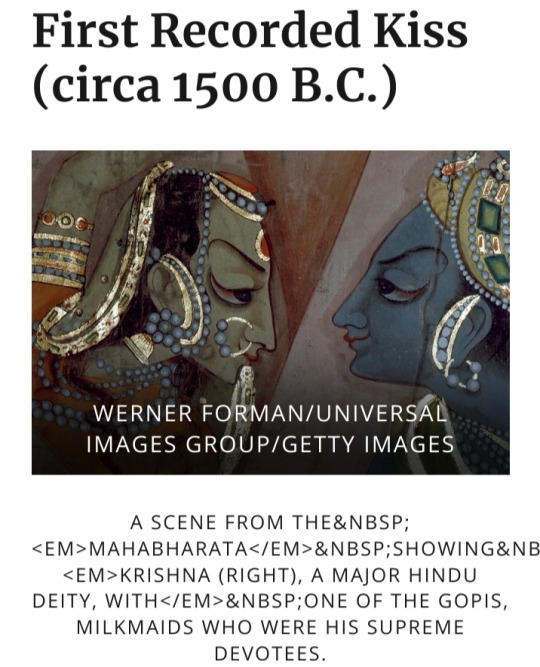
Scholars debate whether kissing began as a trend that spread around the globe, or sprung up organically in different regions.
Whatever the case, the earliest known written mentions of it are in Vedic Sanskrit scriptures circa 1500 B.C., according to research by Vaughn Bryant, an anthropology professor at Texas A&M University.
These scriptures, known as the Vedas, were foundational to the religion of Hinduism.
After that, kissing continued to appear in ancient Indian and Hindu literature.
The Mahabharata, a Sanskrit epic compiled by the 4th century A.D., has a line in which someone “set her mouth to my mouth and made a noise that produced pleasure in me.”
The Kama Sutra, an ancient Sanskrit text on eroticism and love, also has a chapter on kissing that identifies different methods of kissing and types of kisses.
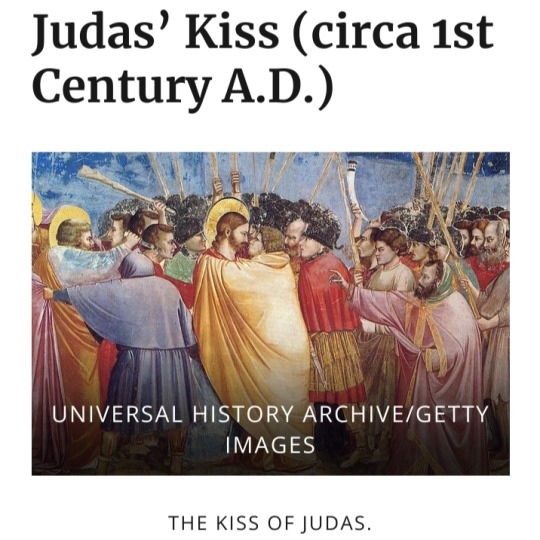
Kissing isn’t just a romantic act. It can also be a sign of friendship or betrayal.
In the Gospels of Matthew and Mark, written circa the 1st century, Judas betrays Jesus by identifying him with a kiss so that armed men can take him away and eventually kill him.
Judas’ kiss has since become a popular storytelling allusion.
It may have inspired the “kiss of death” that appears in mafia literature and film (but was probably never an actual mafia practice).
Perhaps the most famous example is in The Godfather Part II, when Al Pacino’s character gives his brother Fredo the kiss of death for betraying him.
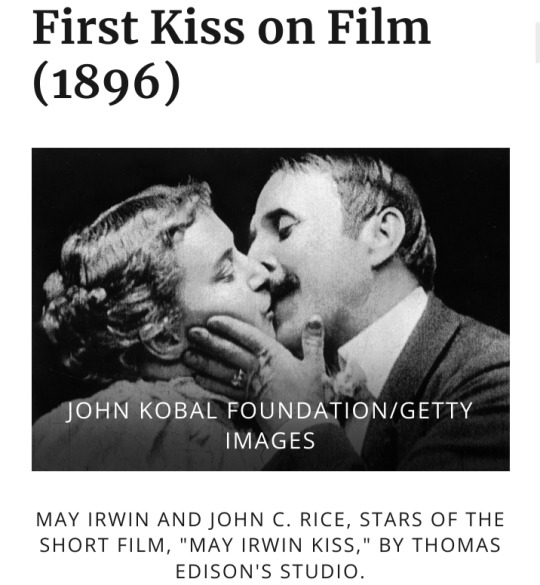
The first people to smooch on film were May Irwin and John C. Rice, who appeared in a short film known variously as May Irwin kiss, Kiss, or The Kiss.
In 1896, the two performers went to Thomas Edison’s studio in New Jersey and reenacted their final kiss scene from a play they were putting on in New York City.
On stage, no one thought the kiss was that sensational. But many felt the close-up footage of them kissing was too risqué.
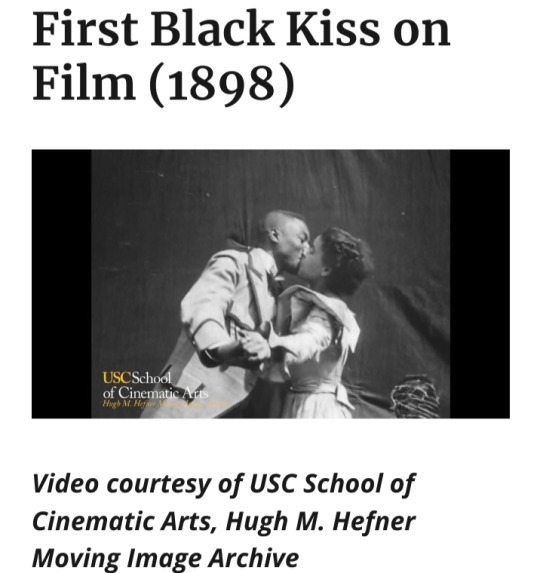
In 1898, black performers Saint Suttle and Gertie Brown starred in a short film titled ''Something Good-Negro Kiss,'' the first film to show Black Americans kissing.
In 2017, film historians rediscovered the footage, which was filmed by a white man named William Selig in Chicago.
“There’s a performance there because they’re dancing with one another, but their kissing has an unmistakable sense of naturalness, pleasure and amusement as well,” Allyson Nadia Field, a professor of cinema and media studies at the University of Chicago who helped identify the film, said in a university press release.
“It is really striking to me, as a historian who works on race and cinema, to think that this kind of artifact could have existed in 1898.”
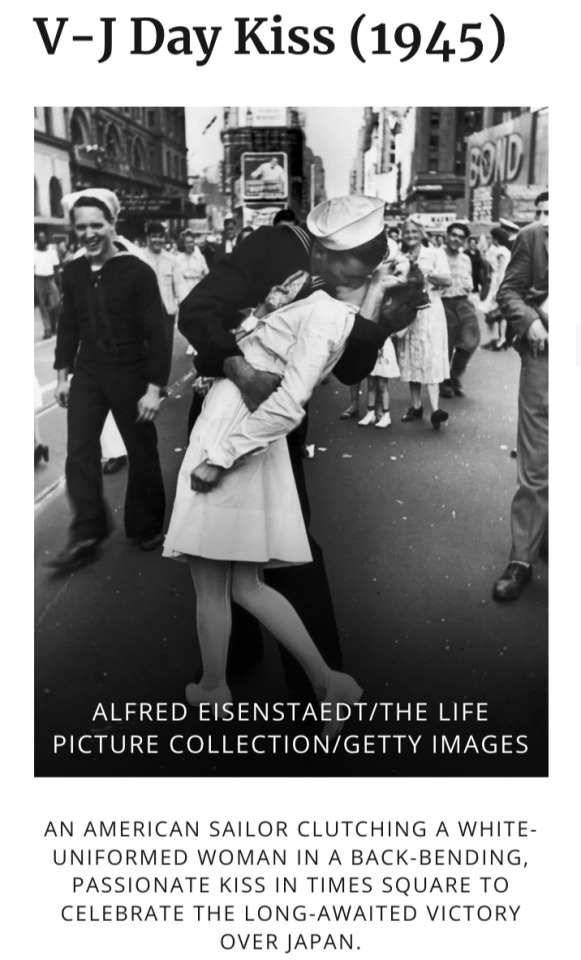
On the morning of 14 August 1945, patients burst into Greta Zimmer’s Manhattan office claiming the war in Japan was over.
The Austrian immigrant wasn’t sure what to think, so on her lunch break, she went to Times Square in her white dental assistant’s uniform to see what the news ticker said.
The atmosphere there was celebratory. The ticker confirmed that it was indeed V-J Day, and World War II was over.
As Zimmer looked away from the ticker, a Navy sailor named George Mendonsan — who’d started drinking early and mistook Zimmer for a nurse — ran up and aggressively kissed her, leaving his girlfriend behind.
Zimmer struggled to push the stranger off, and they parted ways.
But unbeknownst to both of them, photographers Alfred Eisenstaedt and Victor Jorgensen had each captured the moment, as recounted in The Kissing Sailor: The Mystery Behind The Photo That Ended World War II.
Eisenstaedt’s photo became one of the most iconic WWII images in U.S. history, in part because viewers mistook it for a picture of a Naval officer and nurse celebrating together.
The photo has also stirred controversy, as many people have claimed over the years to be the couple in the image, while others point out that it depicts a nonconsensual moment.
Zimmer said in an interview with the Library of Congress in 2005:
“It wasn’t my choice to be kissed...the guy just came over and kissed or grabbed!”

When William Shatner and Nichelle Nichols kissed on a 1968 episode of Star Trek, it was not technically the first interracial kiss on U.S. television.
But it was the one that seemed to have the most cultural impact.
In the episode, titled “Plato’s Stepchildren,” Captain James Kirk and Officer Nyota Uhura encounter aliens who force them to kiss each other through telekinesis.
In Nichols’ book Beyond Uhura: Star Trek and Other Memories, she recalls that NBC was worried how white Americans would react to the scene, so they asked the actors to film two scenes: one with a kiss and one without a kiss.
However, Nichols and Shatner purposefully messed up all of the kissless takes in order to ensure that NBC aired the kissing scene.

During the Cold War, leaders of communist states often greeted each other with what’s called the “socialist fraternal kiss.”
This could be on the cheek or the mouth, but the most famous example is French photographer Régis Bossu’s 1979 picture of the Soviet Union’s Leonid Brezhnev and East Germany’s Erich Honecker kissing on the mouth.
The kiss occurred when Brezhnev visited East Berlin to celebrate the 30th anniversary of the German Democratic Republic (i.e., East Germany).
When the Berlin Wall came down in 1989, the Soviet artist Dmitri Vrubel recreated the image in a mural on the wall’s east side.
He captioned it: “My God, Help Me to Survive This Deadly Love.”
#Memorable Kisses in History#kiss#history#Vedic Sanskrit scriptures#Vedas#The Mahabharata#The Kama Sutra#Judas#Jesus#May Irwin#John C. Rice#Saint Suttle#Gertie Brown#William Selig#Greta Zimmer#Alfred Eisenstaedt#Victor Jorgensen#V-J Day#World War II#Star Trek#William Shatner#Nichelle Nichols#Socialist Fraternal Kiss#Régis Bossu#Leonid Brezhnev#Erich Honecker#German Democratic Republic#Berlin Wall#Dmitri Vrubel#Judas Kiss
5 notes
·
View notes
Text

David Bowie, Chris Taylor, Brian May, Roger Taylor, la principessa Diana, il principe Carlo e Bob Geldof al Wembley Stadium, 1985. Fotografia di Nils Jorgensen
#David Bowie Chris Taylor Brian MayRoger Taylorprincipessa Diana principe Carlo Bob Geldof Stadium#. Fotografia di Nils Jorgensen
4 notes
·
View notes
Text
Transfer rumours
Transfers in:
Goalkeepers: Onuralp Cevikkan (Trabzonspor Kulubu), Marcin Bulka (OGC Nice), Fran Gonzalez (promotion), David Soria (Getafe CF), Joan Garcia (RCD Espanyol), Kepa Arrizabalaga (Chelsea London), Filip Jorgensen (Villarreal CF)
Defenders: Rafa Marin (staying), Leny Yoro (LOSC Lille), Alphonso Davies (Bayern Munchen), Miguel Gutierrez (Girona FC), Trent Alexander-Arnold (FC Liverpool), Joshua Kimmich (Bayern Munchen), Alexandre Penetra (AZ Alkmaar), Mario Gila (S.S. Lazio), Theo Hernandez (AC Milan), Diogo Leite (Union Berlin), William Saliba (Arsenal London), Odilon Kossounou (Bayer Leverkusen), Adrian Liso (Real Zaragoza), Malick Thiaw (AC Milan), Achraf Hakimi (PSG), Reece James (Chelsea London), Riccardo Calafiori (Bologna FC), Vitor Reis (SE Palmeiras), Aymeric Laporte (Al-Nassr FC)
Midfielders: Florian Wirtz (Bayer Leverkusen), Mario Martin (promotion), Franco Mastantuono (CA River Plate), Kevin de Bruyne (Manchester City), Archie Gray (Leeds United), Adrien Rabiot (Juventus Turin/free transfers), Kephrem Thuram (OGC Nice), Tijjani Reijnders (AC Milan)
Forwards: Joselu Mato (RCD Espanyol), Kylian Mbappe (PSG/free transfer), Julian Alvarez (Manchester City)
Transfers out:
Eder Militao: Saudi league
Nacho Fernandez (end of contract): San Diego FC, Inter Milan, Inter Miami, Al-Nassr FC, Al-Ittihad Club, Al-Qadsiah FC
Vinicius Junior: PSG, Al-Ahli Saudi FC
Toni Kroos (end of contract): Manchester City, career end
Luka Modric (end of contract): San Diego FC, Saudi league, Dinamo Zagreb
Rodrygo Goes: Manchester City, FC Liverpool
Andriy Lunin: Atletico Madrid, Manchester United, Arsenal London, PSG, Chelsea London
Joselu Mato (loan end/definite transfer): RCD Espanyol, Al-Gharafa SC
Lucas Vazquez (end of contract): Saudi League
Daniel Ceballos: Atletico Madrid, Newcastle United, Real Betis, AS Monaco
Fran Garcia (loan/buy back option): A.F.C Bournemouth
Brahim Diaz: Borussia Dortmund, Bayer Leverkusen
Antonio Rudiger: Al-Nassr FC
Ferland Mendy: Al-Nassr FC
Arda Guler (loan): Fenerbahce SK, Getafe CF, Real Sociedad, FC Sevilla, UD Las Palmas, RCD Mallorca, AC Milan, RB Leipzig
Kepa Arrizabalaga (loan end): Chelsea London
Reinier Jesus (loan/definitive transfer): Norwich City
Jesus Vallejo (loan/definitive transfer):
Rafa Marin (loan/buy back option): Bayer Leverkusen, SSC Napoli
Peter Gonzalez (loan/buy back option): Getafe CF
Juanmi Latasa (loan/buy back option/definitive transfer): Getafe CF, Real Valladolid
Marvin Park (loan/buy back option/definitive transfer): UD Las Palmas
Alvaro Rodriguez (loan/buy back option): Getafe CF, VfL Wolfsburg, Rayo Vallecano, Eintracht Frankfurt, Deportivo Alaves
Rafael Obrador (loan/buy back option/definitive transfer): Real Zaragoza, S.S. Lazio, UD Las Palmas, Deportivo La Coruna
Nico Paz (loan/buy back option): UD Leganes, Como 1907
Lucas Canizares (buy back option): Rayo Vallecano, Granada CF, Racing Ferrol, CD Eldense, Albacete Balompie, FC Cartagena, SC Farense
Pablo Ramon (loan/buy back option): Real Betis, RCD Espanyol
Mario Martin (loan/buy back option): Real Valladolid
Theo Zidane (end of contract): Cordoba CF
Javi Villar (buy back option): Albacete Balompie
3 notes
·
View notes
Text
The annual 17th of May Parade is being held in Ballard, WA celebrating Norway’s independence from Sweden in 1905. The parade hosts local businesses, sports teams, and Scandanivan-themed floats that travel through the main street.
The parade will begin at the corner of NW 62nd Street in Ballard, WA. The event runs from 10:00 a.m. to 9:00 p.m. However, the float parade runs from 6:00 p.m. to 8:00 p.m. Admission is free and free parking will be provided for all attendees. You may want to bring cash because there are booths as well as local restaurant bars surrounding the perimeter of the parade. The 17th of May parade was founded in 1974 in Ballard, WA this has led to a tradition that has lasted 49 years and has become a staple of this community. Many attendees have been participating in this event since its origins.
Dentist, and local resident of Edmonds, John Tobin, has been attending the 17th of May parade since 1974 and has also participated in the parade as well. John’s former place of business ran a Viking longship float in the parade for 10 years but stopped during the Covid pandemic. Tobin’s father began taking him when he was just a boy and has continued the family tradition ever since. Tobin described how this event united the community.
“Norwegians from all over Washington love the 17th of May because it unites all of us together…. There’s no better way to celebrate Syttende Mai,” said Tobin.
Grandmother and resident of Ballard, Ellie Jorgensen, shared her experience growing up and being a part of the May 17th tradition. Jorgensen began attending the parade when she moved from Bergen, Norway to Ballard, Washington in 1980. Shortly after she had two boys and began involving them in the parade. Through the years the Jorgensen family has attended every 17th of May. Jorgensen’s two sons have continued the family tradition into their adulthood and have brought their children to this year's parade.
“17th of May has been such a heartwarming tradition because it includes the whole family coming together to celebrate. Close friends and family make this celebration special. It has become a great tradition for many families,” said Jorgensen.
The 17th of May parade features primarily Norwegian music, dances, and culture and is accompanied by many Norwegian flags. The sidewalks of the parade are packed with ecstatic attendees all waving flags and cheering for the parade. There are many Scandanvian-styled bars surrounding the main street, including many Nordic beers, mead, and ales. Along with the refreshments are hot dogs and scone stands.
3 notes
·
View notes
Video
youtube
HAPPY BIRTHDAY to June Allyson, Mary Badham, Amiri Baraka, film composer Marco Beltrami, Toni Braxton, Pastor Paul Boxmeyer, Lewis Capaldi, the Broadway run of CATS! (1982 and went for 18 years), Simon Cowell, conductor Charles Dutiot, Allen Ginsberg’s HOWL (1955), Kevin Godley, Taylor Hicks, activist-songwriter Joe Hill, Dave Hope (Kansas), drummer Jo Jones, musician/engineer Sven Jorgensen (thank you for the amazing mixes you did on my YELLOW HOUSE album), Bernard Lavilliers, Yo-Yo Ma, Al Martino, John Mellencamp, Tim Minchin, musician-entertainer Rick Moher, Vaughan Monroe, Nathaniel Raitleff, The Rolling Stones version of “I Wanna Be Your Man” (1963), Judee Sill, Michael W. Smith, composer William Still, Tico Torres, Desmond Tutu, Tata Vega, Thom Yorke, and singer-songwriter, guitarist extraordinaire, and journalist for Guitar Player magazine Jimmy Leslie. When he’s not doing his “freaky freehand” fretwork as guest guitarist for Shana Morrison and other acts, he’s with his band Spirit Hustler doing his cosmic rock that, on an interplanetary jukebox, would play between The Allman Brothers, David Bowie, Funkadelic, and Pink Floyd. I’m grateful for the studio sessions and live shows we’ve been able to do together…check out Jimmy’s page: https://www.facebook.com/Jimmy-Leslie-Music-244868758879482/ + here’s a recording we did together w/singer-songwriter Scott Newiger https://www.youtube.com/watch?v=043pMjcgNZo ...and HB JL. Thank you for your years of twanging out joy.
#jimmyleslie #birthday #guitarplayer #johnnyjblair #sanfrancisco #oakland #singersongwriter #shanamorrison
#jimmy leslie#birthday#guitar player#Johnny j blair#San Francisco Bay area#singer songwriter#Shana Morrison
0 notes
Text
"Heart of Rome" (1970/1971)
youtube
Written by Geoff Stephens, Alan Blaikley and Ken Howard, recorded by Elvis Presley on June 6, 1970 at the RCA’s Studio B in Nashville, Tennessee, "Heart of Rome" was released on the album "Love Letters from Elvis" on June 16, 1971.
MUSICIANS FOR THE TRACK Guitar: James Burton, Chip Young, Elvis Presley. Bass: Norbert Putnam. Drums: Jerry Carrigan. Piano: David Briggs. Organ & Harmonica: Charlie McCoy. OVERDUBS, Guitar: James Burton. Organ: David Briggs. Percussion: Jerry Carrigan. Percussion & Vibes: Farrell Morris. Steel Guitar: Weldon Myrick. Trumpet: Charlie McCoy, George Tidwell, Don Sheffield, Glenn Baxter. Saxophone: Wayne Butler, Norman Ray. Flute, Saxophone & Clarinet: Skip Lane. Trombone: Gene Mullins. Flute & Trombone: William Puett. Vocals: Elvis Presley, Mary Holladay, Mary (Jeannie) Green, Dolores Edgin, Ginger Holladay, Millie Kirkham, June Page, Temple Riser, Sonja Montgomery, Joe Babcock, The Jordanaires, The Imperials.
THE RECORDING SESSION
Studio Sessions for RCA on June 6, 1970: RCA’s Studio B, Nashville The last entry of the evening, “Heart Of Rome,” was an up-tempo dramatic ballad in the operatic vein of “It’s Now Or Never” or “Surrender”; it may have had a little more irony going for it than the earlier cuts, but by the end it had Elvis straining for the high notes — and the band struggling to keep awake. Excerpt: "Elvis Presley: A Life in Music" by Ernst Jorgensen. Foreword by Peter Guralnick (1998)
The song was recorded on the same day as the hits "You Don't Have To Say You Love Me" and "Just Pretend", as well as "I Didn't Make It On Playing Guitar", "It Ain't No Big Thing ( But It's Growing)", "This is Our Dance" and "Life".
It was past midnight when they were working on "Heart of Rome", the last song recorded that night. Elvis, the recording team and musicians spent about ten hours working at the RCA's studio during the Nashville sessions from June 4 to 8, 1970, reporting each evening at 6pm and working until the wee hours, wrapping up the sessions around 4:30 am. Elvis and his band recorded 35 masters over the five-days 1970 recording sessions in Nashville.
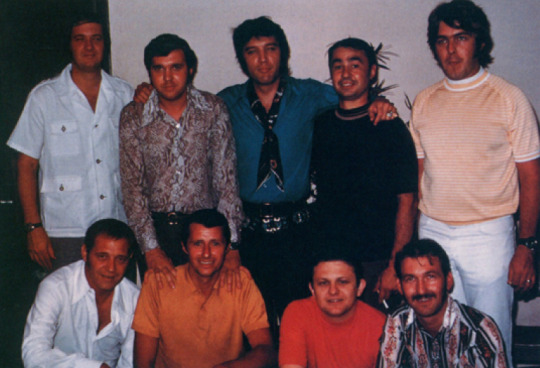
June 1970, at RCA's Studio B in Nashville, Tennessee.
Top (left to right) David Briggs (piano), Norbert Putnam (bass), Elvis (vocals and guitar), Al Pachucki (engineer), Jerry Carrigan (drums/percussion); bottom Felton Jarvis (producer), Chip Young (guitar), Charlie McCoy (organ & harmonica/trumpet), James Burton (guitar).
ADDITIONAL INFO
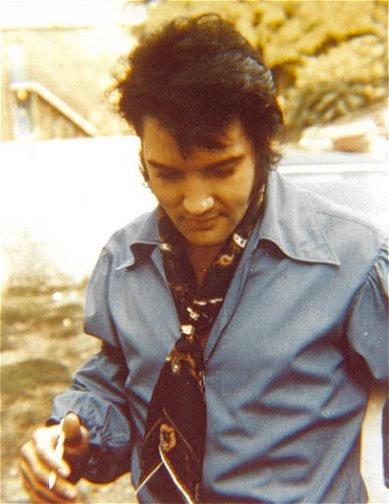
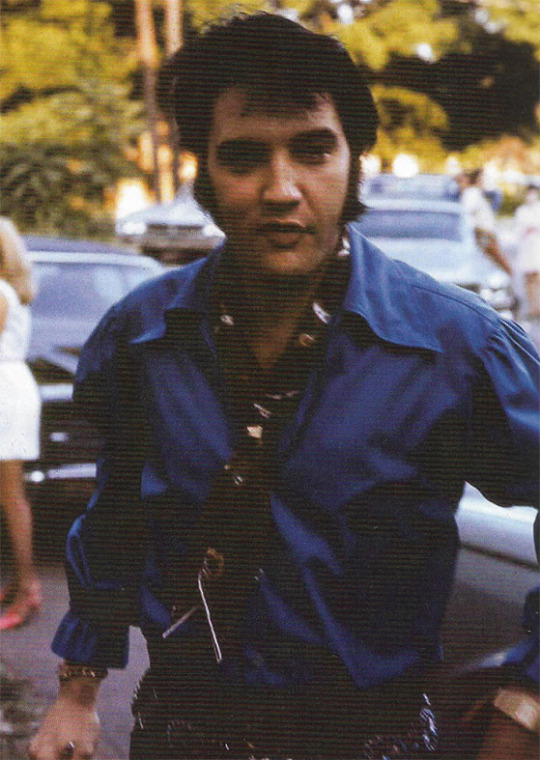

Elvis on June 4, 1970 in Nashville, stepping out of a car at RCA's studio B parking lot on his way to the studio's back entrance. Photography source: elvis-collectors.com.
During that first recording session in Nashville in June 1970, Elvis would record the songs "Twenty Days And Twenty Nights", "I've Lost You", "I Was Born About Ten Thousand Years Ago", "Little Cabin On The Hill", "The Fool", "The Sound Of Your Cry", "A Hundred Years From Now" and "Cindy, Cindy".
#“Heart of Rome” is currently my N.1 most played song on my Spotify#I guess that can tell which song of Elvis is my favorite of all#there's something about this song that is so dreamy#i know its kinda a sad song but its also very touching... missing the one person you want to spend more time with like its never enough 🥹#its so beautiful#absolutely one underrated elvis song#i get goosebumps every damn time i listen to this track#cant and won't ever get over it#elvis presley#elvis music#1970-1971#love letters from elvis#Youtube
13 notes
·
View notes
Text
El primero (1920)

La selección española en los JJ.OO. de Amberes en 1920 (Marca).
Hoy se cumplen 104 años del primer partido oficial de la selección española. Los dirigidos por Paco Bru derrotaron 1-0 a Dinamarca en partido válido por los Juegos Olímpicos celebrados en Bélgica.
España sorprendió al mundo con una victoria contra todo pronóstico, el gol de Patricio Arabolaza, jugador del Real Unión de Irún, bastó para eliminar a uno de los principales candidatos al título.
Dinamarca: Hansen; Middelboe, Blicher; Grothan, Lykke, Aaby; Dannin, Rohde, Viggo Jorgensen, Olsen, Andersen (Entrenador: Carr) España: Zamora; Otero, Arrate; Samitier, Belauste, Eguiazábal; Pagaza, Sesúmaga, Patricio, Pichichi, Acedo (Entrenador: Francisco Bru) Árbitro: Wilhelm Eymers, holandés. Anuló un gol a Patricio por fuera de juego.
0 notes
Text
Drummer, remembering Etienne
Dom Orejudos
(Etienne)
Domingo Francisco Juan Esteban " Dom " Orejudos, Secundo (1 de julho de 1933 - 24 de setembro de 1991), também amplamente conhecido pelos pseudônimos Etienne e Stephen , foi um artista assumidamente gay , bailarino e coreógrafo, mais conhecido por sua inovadora erótica gay masculina a partir da década de 1950. Junto com os artistas George Quaintance e Touko Laaksonen ("Tom da Finlândia") - de quem se tornou amigo - a arte com tema de couro de Orejudos promovia uma imagem de homens gays como fortes e masculinos, como uma alternativa ao estereótipo então dominante como fracos e efeminados. Com seu primeiro amante e parceiro de negócios Chuck Renslow , Orejudos estabeleceu muitos marcos da cultura gay masculina do final do século XX, incluindo o bar Gold Coast , a casa de banho Man's Country , a competição International Mr. Leather , a August White Party de Chicago , e as revistas Triumph , Rawhide e Mars . Ele também foi ativo e influente na comunidade de balé de Chicago.
Vida pregressa
Dom Orejudos nasceu em Chicago , onde estudou na McKinley High School , tocou violino na orquestra da escola, atuou como spalla na orquestra da All Chicago High School e competiu no time de ginástica.
Orejudos estava no ensino médio quando seus primeiros trabalhos eróticos foram publicados, então ele escolheu publicar sob um pseudônimo; ele supostamente desejava "um pseudônimo com estilo real", então ele escolheu a versão francesa de seu nome do meio: Etienne.
Orejudos frequentou a Escola do Instituto de Arte de Chicago por um semestre, onde estudou desenho e arte, mas ficou frustrado com a abordagem ensinada lá. Quando tinha 20 anos, foi abordado na Oak Street Beach de Chicago por Chuck Renslow (então com 23 anos), que o convidou para ser modelo para fotografias. Eles começaram um relacionamento. Eles também fundaram o Kris Studios, um estúdio de fotografia física que tirava fotos para revistas gays que eles publicavam. O estúdio foi nomeado em parte para homenagear a pioneira transgênero Christine Jorgensen .
Carreira
Arte
Orejudos começou a desenhar comercialmente em 1953, quando foi contratado para desenhar ilustrações eróticas para Tomorrow's Man , uma revista publicada por Irv Johnson, o dono da academia onde ele treinava. Ele adotou o pseudônimo Etienne , o equivalente francês de seu nome do meio Esteban. Ele assinou desenhos a caneta e tinta feitos em um estilo ligeiramente diferente com Stephen , o equivalente inglês de seu nome do meio, para sugerir que o estúdio empregava vários artistas. O último tipo de desenho se tornou a base para livros de histórias, entre os primeiros quadrinhos homoeróticos explícitos publicados.
Em 1958, Orejudos e Renslow compraram o ginásio de Johnson, que renomearam para Triumph Gymnasium and Health Studio, movendo o estúdio de fotografia para um andar superior. Em 1963, eles expandiram seu empreendimento editorial para lançar Mars , uma revista abertamente focada em couro . Eles também produziram curtas-metragens de 16 mm com temática gay não explícita, escritos e dirigidos por Orejudos.
Orejudos e Renslow viveram na mansão Francis J. Dewes no início dos anos 1970; Orejudos abrigou seu estúdio de arte no terceiro andar. Depois de perder grande parte de seu arquivo em uma enchente de encanamento na década de 1970, ele deu o restante para o Target Studio, que se tornou seu principal editor. Em 1978, ele teve uma exposição conjunta em uma galeria em São Francisco com o artista erótico Al Shapiro (A. Jay).
Orejudos projetou o logotipo do International Mr. Leather, bem como muitos dos materiais publicitários e produtos do concurso. Ele também pintou murais para o bar Gold Coast (com a ajuda de Chuck Arnett , Man's Country Bathhouse, Zolar's, Mineshaft e Club Baths Kansas City. A arte de Orejudos foi amplamente divulgada por meio de revistas gays como Drummer .
Orejudos era um amigo por correspondência de Tom of Finland e apresentou Tom a Durk Dehner , com quem Tom fundou sua empresa e fundação homônima. Dehner considerou Orejudos seu "melhor amigo por muitos anos" e em 1999 escreveu: "[Orejudos] está indelevelmente ligado a Tom e a mim, e, portanto, à eventual criação da Foundation Tom of Finland ."
A arte de Orejudos foi exibida no Fey-Way Studios , no Mary and Leigh Block Museum of Art da Northwestern University , no Chicago History Museum , no Leather Archives & Museum , e no Roger Brown Study Collection Center da School of the Art Institute of Chicago . Em 1986, Orejudos foi destaque no Naked Eyes, uma mostra de artistas organizada por Olaf Odegaard que destacou a arte visual de homens gays para o International Gay and Lesbian Archives.
Balé
Orejudos frequentou a Ellis-DuBoulay School of Ballet com uma bolsa de estudos e depois se juntou à Illinois Ballet Company, onde foi dançarino principal por nove anos e se tornou coreógrafo residente. Depois que o Illinois Ballet fechou em 1972, ele criou uma nova coreografia por mais uma década trabalhando com a companhia Delta Festival Ballet em Nova Orleans . Ele criou 18 balés, encenados por 20 companhias regionais de balé, incluindo Washington, DC , Atlanta , Houston , Minneapolis , San Francisco e Omaha . Ele recebeu três bolsas do National Endowment for the Arts . Ele encenou seu balé Charioteer para inaugurar transmissões coloridas pela estação WTTW de Chicago , que recebeu três prêmios Emmy . Ele dançou nas companhias itinerantes de West Side Story , The King and I e Song of Norway .
Vida pessoal
Além de seu relacionamento com Chuck Renslow, em 1969 Orejudos conheceu Robert (Bob) Yuhnke em uma festa de couro em Nova York . Eles desenvolveram um relacionamento de longa distância até que Bob se mudou para Chicago em 1979 para viver com Orejudos. Juntos, eles estabeleceram uma residência em Eldorado Springs, Colorado , em 1980, onde residiram até a morte de Orejudos por complicações de AIDS . Orejudos continuou a passar um tempo em Chicago até a morte de sua mãe em 1984.
Orejudos contraiu pneumonia durante uma viagem com Bob na China antes de se juntar a outros membros de uma delegação da Cidade Irmã de Boulder para uma visita planejada a Lhasa, Tibete, em 1987. Esta doença revelou um diagnóstico de AIDS que contribuiu para o declínio de sua saúde, levando à sua morte por complicações da AIDS em 24 de setembro de 1991. Orejudos foi homenageado com três painéis separados no AIDS Memorial Quilt .
Impacto cultural e legado
O Leather Archives & Museum (LA&M) tem a maior coleção de obras originais de Orejudos (sob seu pseudônimo "Etienne"). O próprio LA&M foi fundado por Renslow em grande parte para exibir e preservar a arte de Orejudos. Seu auditório, que apresenta muitos de seus murais, é nomeado em sua homenagem. O LA&M vende periodicamente mercadorias com a arte de Orejudos.
A arte de Orejudos influenciou consideravelmente o estilo de outros artistas eróticos, incluindo Bill Schmeling .
Em 1999, Dehner escreveu:
Tenho certeza de que Etienne ficará na história homoerótica como o humorista por excelência. Seus formatos típicos têm um ou mais personagens como o alvo da piada, muitas vezes sob severo tormento físico, tudo para a gratificação sexual de outro de seus rufiões. Seu domínio relaxado da ilustração figurativa de desenhos animados, junto com uma habilidade soberba para diálogos de sarjeta, produziu o tipo de história que sempre desejamos ao ler Flash Gordon e Homem-Aranha , mas nunca conseguimos até que Etienne/Stephen entrassem em nossas vidas.
Em 2006, o historiador Jack Fritscher escreveu:
"Se houvesse um Monte Rushmore gay de quatro grandes artistas pop pioneiros, os rostos seriam Chuck Arnett , Etienne, A. Jay e Tom of Finland ."
Em 2018, a marca de moda JW Anderson lançou uma coleção inspirada em Orejudos. No mesmo ano, a revista Dazed relatou:
A razão pela qual os garotos de couro sexy de Orejudos ainda são celebrados hoje é que eles inverteram a suposição de que heterossexualidade e masculinidade estão sempre ligadas. Os homens em suas ilustrações são hipermusculosos, seus braços inflados em proporções gigantescas e seus paus grandes o suficiente para destruir até mesmo o parceiro sexual mais experiente. Essas eram paródias de masculinidade com um toque sexy e irônico: é essa atitude disruptiva que lhe rendeu a reputação de um verdadeiro pioneiro queer .

272 notes
·
View notes
Text

By: SEGM
Published: Jun 21, 2023
In a new peer-reviewed commentary published in the Journal of Sex & Marital Therapy, author, Dr. Sarah Jorgensen, argues that the medical community has a professional responsibility to recognize detransitioners as survivors of iatrogenic harm and provide them with the comprehensive medical and supportive care that they deserve.
Jorgensen notes that proponents of gender-affirming medical interventions have attempted to downplay regret and detransition as vanishingly rare based on outdated studies that are not applicable to cohorts of adolescent trans identifying females presenting to gender clinics today. They refuse to admit that the gender-affirming model is failing some patients and have instead tried to reframe detransition as neutral or even positive outcome, proposing euphemisms such as “gender journey,” “identity exploration,” or “dynamic desires for gender-affirming medical interventions,” to replace the term “detransition."
“Rather than acknowledging the severity of the problem or that the medical community bears responsibility for the harm done to these young people, the message is that there have been no mistakes - the situation is dynamic.”
Instead of asking what went wrong, what was missed, and what could have been done differently to prevent inappropriate medical transitions, proponents of gender-affirming care repeatedly make appeals to authority, “every major medical association in the United States supports gender-affirming care for minors,” seemingly oblivious to the move away from American-style affirmation-on-demand in many European countries:
“A growing number of health authorities in countries that were once proponents of youth medical transition are now changing practice and prioritizing psychotherapy and treatment of co-occurring developmental, psychosocial, and mental health problems after their own systematic reviews found the evidence supporting gender-affirming medical interventions to be weak and uncertain.”
Many detransitioners report that they find it challenging to access clinicians who can advise them on what to expect when discontinuing hormones or who have the knowledge and training to manage enduring adverse effects of hormonal therapies and surgical complications. Jorgensen notes that there is currently no guidance on best practices for clinicians involved in the care of detransitioners:
“The World Professional Association for Transgender Health (WPATH) recently published its eighth Standards of Care document and chose not to include a chapter on detransition (Coleman et al., 2022). Likewise, the Endocrine Society’s Clinical Practice Guidelines for Gender-Dysphoria/Gender-Incongruence offers no advice on how to safely stop hormonal therapies (Hembree et al., 2017). The American Academy of Pediatrics failed to acknowledge the possibility of regret and detransition in their policy statement on care for children and adolescents with gender dysphoria (Rafferty et al., 2018).”
Jorgensen highlights multiple areas of uncertainty that will require open discussion and a commitment to clinical collaboration and research to resolve.
“We do not know what is driving the sharp rise in the number of young people being diagnosed or self-diagnosing with gender dysphoria (Cass, 2022; Kaltiala-Heino, Bergman, Tyolajarvi, & Frisen, 2018; Zucker, 2019). Likewise, we do not know why the case mix has rapidly shifted from predominantly young boys and middle-aged men to primarily adolescent females with complex mental health problems and neurodiversity (Aitken et al., 2015; Kaltiala-Heino et al., 2015; Zucker, 2019). The natural trajectory of transgender identification in this novel cohort is uncertain and we cannot predict who will be helped by gender-affirming medical interventions or who will be harmed. The long-term safety and effectiveness of these interventions is yet unknown (Hembree et al., 2017; Ludvigsson et al., 2023; NICE, 2020a, 2020b).”
Importantly, Jorgensen emphasizes that “we miss out on urgently needed data that could improve the outcomes of future patients by ignoring detransitioners.”
SEGM's Thoughts
The rate of medical detransition in the Western countries currently stands at 10-30% and is expected to grow. A number of the detransitioned patients will have permanent unwanted changes to the bodies and adverse long-term impacts on their physical and psychological health.
There is an urgent need to recognize detransition as a new phenomenon, and to structure the healthcare system in order to support this vulnerable patient population. However, due to the novelty of the detransition phenomenon, no diagnostic or procedure codes currently exist that either accurately capture the detransitioned patients' condition, or ensure provider reimbursement for the medical and mental health services that patients will need.
For this reason, it is urgent that the medical community initiate a conversation about what types of diagnostic and procedure codes are necessary to ensure the provision of high quality care to the individuals who detransition.
#SEGM#Society for Evidence Based Gender Medicine#detrans#detransition#iatrogenic harm#sex trait modification#medical malpractice#medical scandal#medical transition#medical corruption#transition regret#gender ideology#ideological corruption#ideological capture#queer theory#genderwang#religion is a mental illness
48 notes
·
View notes
Text
El Chelsea anuncia oficialmente el fichaje de Joao Félix

Recientemente, el Chelsea anunció oficialmente el fichaje del delantero portugués Joao Félix. Las dos partes firmaron un contrato de larga duración por 7 años.
Después de dos cesiones, camisetas Chelsea Joao Félix sintió que era hora de establecerse en algún lugar y no había mejor lugar que el Chelsea. Joao Félix comenzó su carrera en el Benfica y luego se unió al Atlético de Madrid por una transferencia récord, pero no logró encontrar una posición adecuada en el sistema táctico de Simeone, lo que lo llevó a ser cedido al Chelsea y al Barcelona. Félix es capaz de jugar en múltiples posiciones en la zona de ataque, incluido el delantero centro, el extremo y el mediocampista ofensivo. Su flexibilidad y capacidad técnica lo hacen muy importante en primera línea. En la nueva temporada, el Chelsea también realizó una serie de fichajes importantes en la ventana de transferencias de verano, incluidos Pedro Neto, Filip Jorgensen, Kiernan Dewsbury-Hall y Tosin Adarabio About et al. ¡Los fanáticos que visten camisetas de fútbol esperan ver al equipo avanzar y lograr mejores resultados en la nueva temporada!
0 notes
Text
🇺🇲Lance Armstrong advierte a 🇸🇮Tadej Pogacar de que va por el mal camino: "Está cometiendo el mayor error de toda su carrera"
🔥La victoria de Tadej Pogacar en 🏔️Isola 2000 ha causado revuelo. Lance Armstrong incluso criticó al próximo ganador del Tour de Francia en su podcast The Move:
🎙️"Lo que vimos aquí es el mayor error de toda su carrera. Te lo prometo", asegura Armstrong. "A los otros equipos no les gusta esto... Puedes decir que a la gente de Eslovenia le gusta, sí, pero también estás corriendo contra Remco Evenepoel y contra Jonas Vingegaard, de Bélgica y Dinamarca. Dos grandes países del ciclismo. Usted está corriendo en Francia, con los medios de comunicación franceses. Es un gran error por su parte".
"Luego oigo las reacciones: es una carrera. Sí, es cierto, pero también es una campaña política. No des a la gente una razón para odiarte. Y me gusta repetirlo: no les des una razón para odiarte. ¿Y si eso es demasiado? Entonces no les des una razón para que no les gustes. Y aún más importante: No les des una razón para dudar de ti. No les des la oportunidad de cuestionar tu grandeza. Y él lo hizo, ese fue su mayor error".
"Soy un gran admirador de Tadej Pogacar. Como aficionado y simpatizante le dije: no hagas esto, no hagas esto. Quería lo mejor para él. Podría haber alcanzado a Jorgensen y haberse llevado una etapa. He vivido muchas de estas situaciones. En el Mont Ventoux dejé que Marco Pantani ganara la etapa, pero él no estaba contento. Fue como un golpe adicional para él. Tampoco me sentí bien. Pero Pogacar tiene que mirar al podio final de Niza. Esa es la verdadera victoria". #TDF2024

0 notes